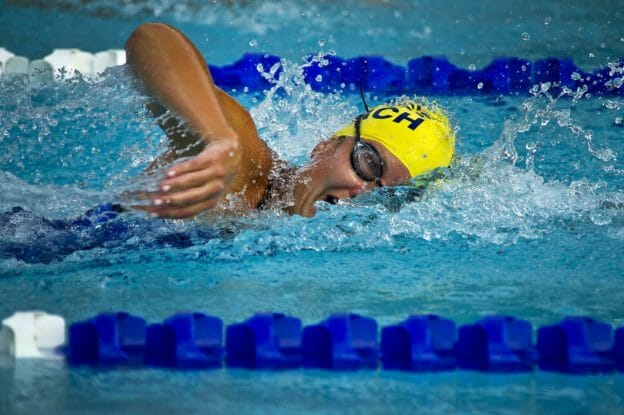While technology is extremely important to the advancement and progress of swimming, we need to be very careful about how we use this new information. If the tests are not done properly, if the data is not collected accurately, or if it is misinterpreted or misunderstood, it will no longer be of any value. In fact, it can hurt us by giving us wrong information or advice.
For example, in an article written in Russia about Alex Popov in the 90’s, when he was Czar of the sprints, the author demonstrated that Alex’s velocity was greatest when one hand was out in front and the other hand was nearing the end of the pulling cycle. The author erroneously concluded that there must be more propulsion at the end of the pulling cycle than in the middle, leading coaches all over the world to teach swimmers to push the hand hard backward at the end of the freestyle pull. In fact, the increase in Popov’s velocity was not derived from increased propulsion at the end of the pull but rather from the increase in propulsion in the middle of the pull followed by a reduction of frontal drag as the arms took on a more linear position with the body.
Recently, Triton, a Canadian manufacturer of wearable technology that provides loads of information to coaches, included a Stroke Index, which they claim determines how efficient a swimmer is in a given stroke. Although this index is meant to be well intended, it may actually be misleading.
The Stroke Index (SI) is defined as a swimmer’s velocity (V = m/sec) times his/her distance per stroke (not cycle) (DPS = m/stroke). SI = V x DPS. While we understand DPS is important and V is the ultimate goal, here are the problems I have with the Triton Stroke Index.
First, the SI is not a measure of stroke efficiency. Physiological efficiency of any stroke is measured in the same way we measure efficiency of a car (miles per gallon), except we use meters/Kcalories burned. While efficiency may be important, no driver wins an auto race with great gas mileage, nor do swimmers win swimming races with the highest efficiency. They both expect to burn a lot of gas or calories in order to get the job done. The challenge of measuring efficiency of a swimmer is that it is not easy to measure the precise number of Calories expended during a race. But who really cares? We want to know who wins, not who burned the least number of calories.
Mechanical efficiency is based on having the lowest fluctuation in velocity, which may have little to do with the SI. It has more to do with law of inertia.
When we analyze the Stroke Index further, this is what we find. A swimmer’s velocity (V) is equal to the DPS (m/stoke) times the Stroke Rate (SR) (strokes/sec). Therefore, SI = DPS x DPS x SR or DPS ² x SR.
What the SI does is give more weight to DPS than to SR. Yet, when determining V, the ultimate goal of a swimmer, the SR and DPS have equal weight. V = SR x DPS.
As an example, let’s say Sun Yang is battling against Ryan Cochrane in a 1500 m freestyle race. Sun uses a hip driven freestyle and has a stroke rate of 60, while Ryan uses shoulder driven technique with a SR of 86. If we assume they are swimming at the same speed, that means Sun Yang’s DPS is significantly greater than Ryan’s. The reason may be because of the longer wing span resulting in more arm propulsion, the two strong surge kicks that he uses in each stroke cycle, more energy on his coupling motions (body rotation and arm recovery), lower frontal drag, or some combination of all of those. The point is that since the SI is derived from the square of DPS only, Sun Yang will have a higher SI value than Ryan. Yet they are swimming at about the same speed. If one were to compare the SI value between Sun Yang and Gregorio Paltrinieri, who swims the 1500 at around a 96 stroke rate, the difference would be even greater.
Without being able to measure calories burned, it is not clear to me which of these three different freestyle techniques is more efficient, since the stroke rates and the kicking rates and intensities are quite different. The differences in SI values does not necessarily reflect efficiency.
The SI places an unfair advantage on DPS, which will be higher in hip driven or hybrid freestyle technique than with shoulder driven technique. No elite swimmer uses hip driven freestyle in the 50 m sprint nor the 100 m and nearly all elite women use shoulder driven freestyle for all distances.
If one wanted to use the SI as a means to exaggerate the differences between good and poor technique, then a better idea would be the following equation: SI = V x DPS x SR or SI = DPS ² x SR ² or SI = V ². I’m not certain that this is necessary nor helpful, but would hopefully help prevent coaches from trying to convert their swimmers to hip driven freestyle or slow stroke rate backstroke or long, gliding breaststroke or butterfly, which they might do with the SI as currently defined. I would say that Caeleb Dressel, Adam Peaty, Lilly King and virtually all elite backstrokers that generally use fast stroke rates would not be happy with the current SI.
Yours in Swimming,
Gary Sr.
Technology in Swimming Part II

